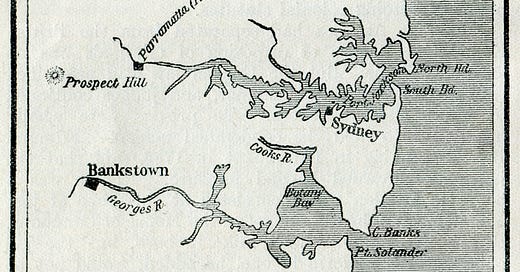What do you do with people convicted of breaking the law? There have been many different responses to that question throughout history. You could do nothing, perhaps descending in an archaic society. You could fine someone, entrusting that the loss of money would be enough to ensure they’ve “learned their lesson.” You could cut off a body part, marking their shame to the rest of society. You could imprison them, keeping them separate from the wider world due to the abhorrent nature of their crime. You could enslave them, making sure they work off their debt to society. You could execute them, ending any issue of them committing another crime. There’s no one right solution, and all have their own issues.
Taking a page from the ancient Greek world, the British chose to exile some of their convicts. Whereas the ancient Greeks told people they couldn’t live in that city any longer – they had to leave Athens, but were free to settle anywhere else, for example – the British went even further. (It should be noted that “the Greeks” were not a unified peoples with a single purpose like the ancient Egyptians, Romans, or Chinese. They were, at best, a loose confederation of competing city-states with shifting allegiances and fortunes. They did share a language and mythological framework, but their political, cultural, and military institutions were vastly different.) Anyway, the Greek city-states didn’t provide their convicts with money or transportation. The British, though, shipped their convicts to a whole different continent. Ingenious, really. Or diabolical. Whatever, take your choice. The British did have to pay for the guards and ships used to move them, but once they arrived on the new continent they were left to fend for themselves. Okay, that’s not completely true.
The first of those convict exile ships arrived into Botany Bay, New South Wales, on this date, 18 January 1788. After Captain James Cook became the first known European to land in Australia in 1770 during his voyages exploring the South Pacific (where he could not confirm the existence of Bouvet Island, the world’s most remote island you may recall), there was a large cry to found a British colony in Australia. This was, after all, the age of expansion for the British Empire. They had founded (and inherited) colonies all throughout the Americas, including the West Indies and Caribbean, established the East India Company (more on that in a future edition), and obtained territories in India. To them, the lands of the South Pacific were a natural place for a colony.
No matter that it was already inhabited by hundreds of indigenous cultures for as many as 60,000 years. These native inhabitants spoke in more than 250 distinct language groups, and have maintained distinct artistic and religious traditions for the longest known span in the world. But the British didn’t care about that.
The fleet consisted of eleven ships – two Royal Navy armed gunships, three supply ships, and six convict transports. The first to arrive was one of the gunships, His Majesty’s Armed Tender (HMAT) Supply. Within three days all the ships had arrived, and Australia had the first British settlement made up of roughly 1400 people that included convicts, marines, sailors, civil officers, and free settlers.
Most of the convicts who made up the new colony had been convicted of theft, perjury, fraud, assault, and robbery. They were originally sentenced to death in Britain, which were then commuted to this “penal transportation.” Marines volunteered for the service, which made up the New South Wales Marine Corps and had a detachment on each convict transport. Unlike the convicts, the marines were able to bring their families along for the voyage and settlement.
This First Fleet left from Portsmouth, England on 13 May 1787. Over the course of more than 250 days they traveled more than 15,000 miles down the west coast of Europe and Africa, to South America, around the Cape of Good Hope, and through the Indian Ocean until landing on the east coast of Australia. Quite the voyage!
The colonists soon realized that Botany Bay was not suitable for habitation, as it was open and unprotected, had water too shallow to anchor close to the shore, lacked fresh water, and had poor soil for growing crops. They sent a small expedition to explore the area, and just eight miles away found Port Jackson, in what is now Sydney. This port is the location of the Sydney Opera House and Sydney Harbor Bridge.
After disembarking some of the ships of the First Fleet stayed, some went to other ports for trade or more colonization, and some returned to England. A Second Fleet of colonists arrived in June of 1790. It was the second of many, as Australia is now highly developed and integrated into the world, with membership in many international organizations including the UN, the G20, the World Trade Organization (WTO), the Asia-Pacific Economic Cooperation, the Commonwealth of Nations, and the security organizations ANZUS, AUKUS, and the intelligence network Five Eyes (FYEV). Australia became an independent Commonwealth, free from British authority in 1901, though it remains a close ally. The constitution adopted at that time ensured peoples of the indigenous tribes had the legal right to vote and participate in government. They did live there first, it’s only right that they get a say in how their governed.





